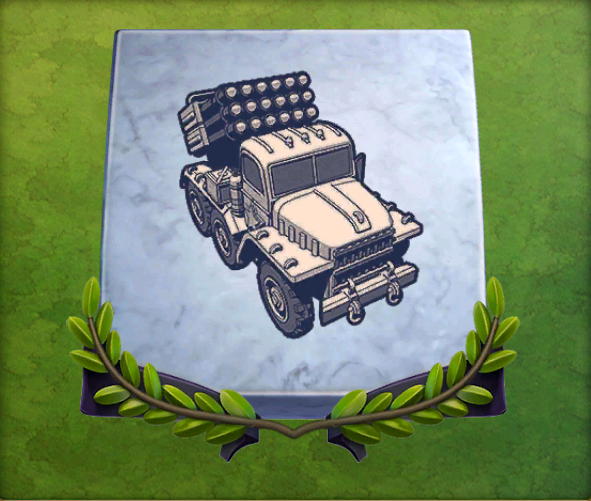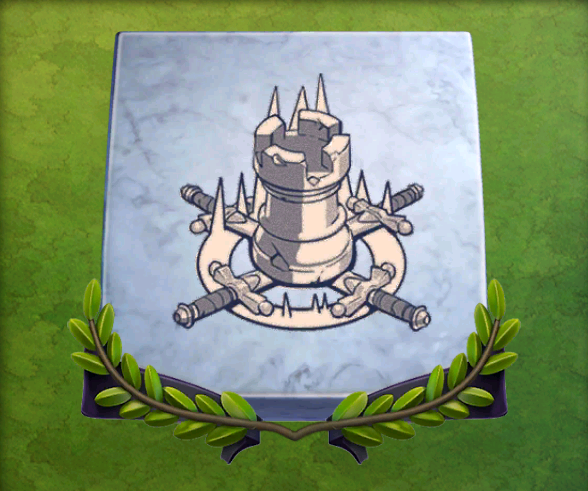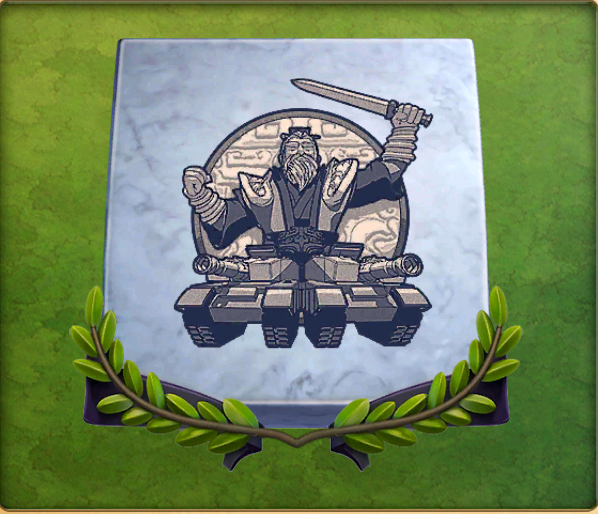
상위 문서:
도미네이션즈/유니버시티
(MRL) DamageMRL 데미지가 증가합니다.

기술 레벨
| 업그레이드 비용(석유)
| 필요 국민
| 업그레이드 시간
| 보너스 비율
|
1
| 20,000
| 2
| 6일
| 3%
|
2
| 30,000
| 7일
| 6%
|
3
| 40,000
| 8일
| 9%
|
4
| 60,000
| 9일
| 12%
|
5
| 80,000
| 10일
| 15%
|
6
| 100,000
| 11일
| 18%
|
7
| 120,000
| 12일
| 21%
|
8
| 140,000
| 13일
| 24%
|
9
| 160,000
| 14일
| 27%
|
10
| 180,000
| 15일
| 30%
|
(MRL) HitpointsMRL HP가 증가합니다.

기술 레벨
| 업그레이드 비용(석유)
| 필요 국민
| 업그레이드 시간
| 보너스 비율
|
1
| 20,000
| 2
| 6일
| 3%
|
2
| 30,000
| 7일
| 6%
|
3
| 40,000
| 8일
| 9%
|
4
| 60,000
| 9일
| 12%
|
5
| 80,000
| 10일
| 15%
|
6
| 100,000
| 11일
| 18%
|
7
| 120,000
| 12일
| 21%
|
8
| 140,000
| 13일
| 24%
|
9
| 160,000
| 14일
| 27%
|
10
| 180,000
| 15일
| 30%
|
Troop Capacity전투에 투입할 수 있는 병력 수가 증가합니다.

기술 레벨
| 업그레이드 비용(석유)
| 필요 국민
| 업그레이드 시간
| 보너스 수량
|
1
| 40,000
| 7일
| 3
| 3
|
2
| 80,000
| 8일
| 6
|
3
| 120,000
| 9일
| 9
|
4
| 160,000
| 10일
| 12
|
5
| 200,000
| 11일
| 15
|
1.4. (정찰기) 스캔 데미지 보너스[편집]
(Recon) Scan Damage Bonus정찰기의 스캔 데미지 보너스가 증가합니다.

기술 레벨
| 업그레이드 비용(석유)
| 필요 국민
| 업그레이드 시간
| 보너스 비율
|
1
| 40,000
| 3
| 7일
| 2%
|
2
| 60,000
| 8일
| 4%
|
3
| 80,000
| 9일
| 6%
|
4
| 100,000
| 10일
| 8%
|
5
| 120,000
| 11일
| 10%
|
6
| 140,000
| 12일
| 12%
|
7
| 160,000
| 13일
| 14%
|
8
| 180,000
| 14일
| 16%
|
9
| 200,000
| 15일
| 18%
|
10
| 220,000
| 16일
| 20%
|
(Recon) Hitpoints정찰기의 HP가 증가합니다.

기술 레벨
| 업그레이드 비용(석유)
| 필요 국민
| 업그레이드 시간
| 보너스 비율
|
1
| 40,000
| 3
| 7일
| 2%
|
2
| 60,000
| 8일
| 4%
|
3
| 80,000
| 9일
| 6%
|
4
| 100,000
| 10일
| 8%
|
5
| 120,000
| 11일
| 10%
|
6
| 140,000
| 12일
| 12%
|
7
| 160,000
| 13일
| 14%
|
8
| 180,000
| 14일
| 16%
|
9
| 200,000
| 15일
| 18%
|
10
| 220,000
| 16일
| 20%
|
The Art of War손자의 영웅 능력인 손자병법이 활성화됩니다. 이 능력이 전투에서 활성화되면 1대의 99식 전차가 소환되며, 근처 아군 유닛의 공격 속도가 15% 증가합니다.

기술 레벨
| 업그레이드 비용(석유)
| 필요 국민
| 업그레이드 시간
|
1
| 180,000
| 4
| 14일
|
Sun Tzu Damage영웅 손자의 데미지가 증가합니다.

기술 레벨
| 업그레이드 비용(골드)
| 필요 국민
| 업그레이드 시간
| 보너스 비율
|
1
| 4,200,000
| 4
| 8일
| 3%
|
2
| 4,500,000
| 9일
| 6%
|
3
| 4,800,000
| 10일
| 9%
|
4
| 5,100,000
| 11일
| 12%
|
5
| 5,400,000
| 12일
| 15%
|
6
| 5,700,000
| 13일
| 18%
|
7
| 6,000,000
| 14일
| 21%
|
8
| 6,300,000
| 15일
| 24%
|
9
| 6,600,000
| 16일
| 27%
|
10
| 6,900,000
| 17일
| 30%
|
Sun Tzu Hitpoints영웅 손자의 HP가 증가합니다.

기술 레벨
| 업그레이드 비용(식량)
| 필요 국민
| 업그레이드 시간
| 보너스 비율
|
1
| 4,200,000
| 4
| 8일
| 3%
|
2
| 4,500,000
| 9일
| 6%
|
3
| 4,800,000
| 10일
| 9%
|
4
| 5,100,000
| 11일
| 12%
|
5
| 5,400,000
| 12일
| 15%
|
6
| 5,700,000
| 13일
| 18%
|
7
| 6,000,000
| 14일
| 21%
|
8
| 6,300,000
| 15일
| 24%
|
9
| 6,600,000
| 16일
| 27%
|
10
| 6,900,000
| 17일
| 30%
|
Sun Tzu Attack Speed영웅 손자의 공격 속도가 증가합니다.

기술 레벨
| 업그레이드 비용(골드)
| 필요 국민
| 업그레이드 시간
| 보너스 비율
|
1
| 4,200,000
| 4
| 8일
| 2%
|
2
| 4,500,000
| 9일
| 4%
|
3
| 4,800,000
| 10일
| 6%
|
4
| 5,100,000
| 11일
| 8%
|
5
| 5,400,000
| 12일
| 10%
|
6
| 5,700,000
| 13일
| 12%
|
7
| 6,000,000
| 14일
| 14%
|
8
| 6,300,000
| 15일
| 16%
|
9
| 6,600,000
| 16일
| 18%
|
10
| 6,900,000
| 17일
| 20%
|
War Tactic Capacity전술 최대 사용량이 1만큼 증가합니다.

기술 레벨
| 업그레이드 비용(석유)
| 필요 국민
| 업그레이드 시간
|
1
| 225,000
| 5
| 16일
|
The Army on the March손자병법이 전투에서 여러 번 활성화되며 사용 후에는 쿨타임 상태가 됩니다. 추가로, 이 능력으로 소환되는 99식 전차 대수가 1대 증가하며, 손자병볍 공격 속도 보너스가 10% 증가합니다.

기술 레벨
| 업그레이드 비용(석유)
| 필요 국민
| 업그레이드 시간
|
1
| 300,000
| 7
| 17일
|
기원전 770년에서 476년에 이르는 춘추시대는 중국 역사 상 격동의 시대였습니다. 동주 왕조는 속방이 생존과 헤게모니를 위해 싸우면서 장악력이 미약했습니다. 하지만, 혼돈 속에서 과학과 지성은 꽃 피웠습니다. 농업의 발전으로 인구가 많이 늘어났습니다. 중국은 석기 시대에 진입하며 석궁을 발명했습니다. 유가, 도가, 법치주의, 묵가 등 제자백가가 권위 있는 철학자들에 의해 만들어졌습니다. 이 훌륭한 사상가들 중 손자가 있습니다.
전통에 따르면 그는 오나라 혹은 제나라에서 기원전 544년에 손무라는 이름으로 태어났습니다. 서양인에게 익숙한 손자라는 이름에는 대가를 의미하는 '자'라는 존칭이 포함되어 있습니다. 아마 그는 군 전략을 짜는 귀족 가문에서 태어났을 겁니다. 그가 오나라 출신인지는 확실하지 않지만, 그는 결국은 합려왕을 위해 일했습니다. 사기에 따르면 손자는 506년에 오나라가 초나라에게 큰 패배를 안겼을 때 오나라의 주요 사령관 중 한 명이었다고 합니다.
그의 실제 이력보다 후세에 더 중요한 것은 동서고금을 막론한 전략서인 손자병법입니다. 이 당시에는 손빈이라는 후손이 동일한 제목의 지침서를 저술했다고 전해지기도 하지만, 손자의 이론은 춘추시대 이후의 전국 시대에는 잘 사용되지 않았습니다. 하지만 결국 중국을 통일한 사람은 손자의 원칙을 따랐기 때문에 목적을 달성한 진 시황제이었습니다. 그는 국가의 세력 확장 능력을 제한한 귀족의 세세한 규칙을 따르기 보다는 완전한 승리를 추구했습니다.
시간이 가면서 손자의 영향력은 커지기만 했습니다. 한나라를 세운 이들은 손자의 가르침에 따라 싸웠습니다. 손견 등, 삼국 시대의 군벌은 손자의 책을 연구했습니다. 손자병법은 중세 일본에서 인기를 얻었고 통일을 이룬 3명의 위인도 손자병법을 애용했습니다. 마오쩌둥은 이를 자신만의 게릴라 전법으로 발전시켰으며, 그의 작은 빨간 책의 일부 내용은 압도적인 힘을 이용한 공격, 장기 포위전 피하기 등, 손자의 병법과 사실상 구분이 안됩니다.
손자병법은 서양에서도 꽤 인기를 끌었습니다. 손자병법은 나폴레옹의 전술 혁신에 지침이 되었을 수 있으며, 노먼 슈워츠코프부터 데이비드 퍼트레이어스까지 현대의 미국 장군들이 직접 인용하기도 했습니다. 이는 전세계의 군사 학교의 필독서일 뿐만 아니라, 전쟁터에서 벗어나 다양한 리더십과 갈등 상황에 적용되었습니다. 손자의 인생에 대한 기록은 별로 없으며, 그가 실제 존재하지 않았을 수 있습니다. 하지만, 그의 이름을 딴 지혜는 2500년 넘게 존재하고 있습니다.
The Spring and Autumn period (c. 770-476 BCE) was a turbulent time in Chinese history. The Eastern Zhou dynasty maintained a tenuous grip on power as their vassals battled for survival and hegemony. Yet scientific and intellectual pursuits flowered amidst the chaos. Improvements in agriculture led to a population boom. China entered the Iron Age and invented the crossbow. The so-called ‘Hundred Schools of Thought’ like Confucianism, Taoism, Legalism, and Mohism were founded by luminary philosophers. Standing tall among these brilliant thinkers is Sun Tzu.
Tradition holds that he was born Sun Wu in 544 BCE in either the state of Qi or Wu. The name familiar to Westerners includes the honorific title Tzu and literally means ‘Master Sun.’ In all likelihood he belonged to an aristocratic clan whose family trade was military strategy. Whether or not he was a native of Wu, he eventually ended up in the employ of its King Helü. The Records of the Grand Historian claim that Sun Tzu acted as one of the main commanders for Wu during their decisive defeat of Chu in 506.
More important to posterity than his actual career is his timeless treatise on strategy, The Art of War. Evidently his theories were little used in the Warring States era that followed the Spring and Autumn period, although during this time an alleged descendant named Sun Bin wrote a companion work with the same title. But the man who at last unified China, Qin Shi Huang, achieved his goal because he obeyed Sun Tzu’s precepts. He pursued complete victory rather than adhering to aristocratic niceties that limited the ability of the state to expand its power.
The influence of Sun Tzu only grew as time went on. The founders of the Han Dynasty fought in accordance with his teachings. Warlords during the Three Kingdoms era, including another supposed descendant called Sun Jian, studied his work. The Art of War became popular in medieval Japan and was favored by its three great unifiers. Mao Zedong adapted it to his own style of guerrilla warfare, and some maxims in his ‘Little Red Book’ are virtually indistinguishable from the ancient master’s: attack with overwhelming force, avoid prolonged sieges, and so on.
The Art of War has gained quite a bit of currency in the West as well. It may have guided Napoleon’s tactical innovations and has been directly cited by modern U.S. generals from Norman Schwarzkopf to David Petraeus. Not only is it required reading in military academies worldwide, it has also been applied to diverse leadership and conflict situations off the battlefield. Although Sun Tzu’s life is not well documented, and it is possible he did not actually exist, the wisdom attributed to his name has endured for over 2,500 years.

이 문서의 내용 중 전체 또는 일부는
문서의
r39 판{{{#!wiki style="display: inline; display: none;"
,
번 문단}}}에서 가져왔습니다.
이전 역사 보러 가기
이 문서의 내용 중 전체 또는 일부는 다른 문서에서 가져왔습니다.
- [ 펼치기 · 접기 ]
문서의
r39 판{{{#!wiki style="display: inline; display: none;"
,
번 문단}}} (
이전 역사)
문서의
r 판{{{#!wiki style="display: inline; display: none;"
,
번 문단}}} (
이전 역사)
문서의
r 판{{{#!wiki style="display: inline; display: none;"
,
번 문단}}} (
이전 역사)
문서의
r 판{{{#!wiki style="display: inline; display: none;"
,
번 문단}}} (
이전 역사)
문서의
r 판{{{#!wiki style="display: inline; display: none;"
,
번 문단}}} (
이전 역사)
문서의
r 판{{{#!wiki style="display: inline; display: none;"
,
번 문단}}} (
이전 역사)
문서의
r 판{{{#!wiki style="display: inline; display: none;"
,
번 문단}}} (
이전 역사)
문서의
r 판{{{#!wiki style="display: inline; display: none;"
,
번 문단}}} (
이전 역사)
문서의
r 판{{{#!wiki style="display: inline; display: none;"
,
번 문단}}} (
이전 역사)
문서의
r 판{{{#!wiki style="display: inline; display: none;"
,
번 문단}}} (
이전 역사)
문서의
r 판{{{#!wiki style="display: inline; display: none;"
,
번 문단}}} (
이전 역사)
문서의
r 판{{{#!wiki style="display: inline; display: none;"
,
번 문단}}} (
이전 역사)
문서의
r 판{{{#!wiki style="display: inline; display: none;"
,
번 문단}}} (
이전 역사)
문서의
r 판{{{#!wiki style="display: inline; display: none;"
,
번 문단}}} (
이전 역사)
문서의
r 판{{{#!wiki style="display: inline; display: none;"
,
번 문단}}} (
이전 역사)
문서의
r 판{{{#!wiki style="display: inline; display: none;"
,
번 문단}}} (
이전 역사)
문서의
r 판{{{#!wiki style="display: inline; display: none;"
,
번 문단}}} (
이전 역사)
문서의
r 판{{{#!wiki style="display: inline; display: none;"
,
번 문단}}} (
이전 역사)
문서의
r 판{{{#!wiki style="display: inline; display: none;"
,
번 문단}}} (
이전 역사)
문서의
r 판{{{#!wiki style="display: inline; display: none;"
,
번 문단}}} (
이전 역사)
문서의
r 판{{{#!wiki style="display: inline; display: none;"
,
번 문단}}} (
이전 역사)
문서의
r 판{{{#!wiki style="display: inline; display: none;"
,
번 문단}}} (
이전 역사)
문서의
r 판{{{#!wiki style="display: inline; display: none;"
,
번 문단}}} (
이전 역사)
문서의
r 판{{{#!wiki style="display: inline; display: none;"
,
번 문단}}} (
이전 역사)
문서의
r 판{{{#!wiki style="display: inline; display: none;"
,
번 문단}}} (
이전 역사)
문서의
r 판{{{#!wiki style="display: inline; display: none;"
,
번 문단}}} (
이전 역사)
문서의
r 판{{{#!wiki style="display: inline; display: none;"
,
번 문단}}} (
이전 역사)
문서의
r 판{{{#!wiki style="display: inline; display: none;"
,
번 문단}}} (
이전 역사)
문서의
r 판{{{#!wiki style="display: inline; display: none;"
,
번 문단}}} (
이전 역사)
문서의
r 판{{{#!wiki style="display: inline; display: none;"
,
번 문단}}} (
이전 역사)
문서의
r 판{{{#!wiki style="display: inline; display: none;"
,
번 문단}}} (
이전 역사)
문서의
r 판{{{#!wiki style="display: inline; display: none;"
,
번 문단}}} (
이전 역사)
문서의
r 판{{{#!wiki style="display: inline; display: none;"
,
번 문단}}} (
이전 역사)
문서의
r 판{{{#!wiki style="display: inline; display: none;"
,
번 문단}}} (
이전 역사)
문서의
r 판{{{#!wiki style="display: inline; display: none;"
,
번 문단}}} (
이전 역사)
문서의
r 판{{{#!wiki style="display: inline; display: none;"
,
번 문단}}} (
이전 역사)
문서의
r 판{{{#!wiki style="display: inline; display: none;"
,
번 문단}}} (
이전 역사)
문서의
r 판{{{#!wiki style="display: inline; display: none;"
,
번 문단}}} (
이전 역사)
문서의
r 판{{{#!wiki style="display: inline; display: none;"
,
번 문단}}} (
이전 역사)
문서의
r 판{{{#!wiki style="display: inline; display: none;"
,
번 문단}}} (
이전 역사)
문서의
r 판{{{#!wiki style="display: inline; display: none;"
,
번 문단}}} (
이전 역사)
문서의
r 판{{{#!wiki style="display: inline; display: none;"
,
번 문단}}} (
이전 역사)
문서의
r 판{{{#!wiki style="display: inline; display: none;"
,
번 문단}}} (
이전 역사)
문서의
r 판{{{#!wiki style="display: inline; display: none;"
,
번 문단}}} (
이전 역사)
문서의
r 판{{{#!wiki style="display: inline; display: none;"
,
번 문단}}} (
이전 역사)
문서의
r 판{{{#!wiki style="display: inline; display: none;"
,
번 문단}}} (
이전 역사)
문서의
r 판{{{#!wiki style="display: inline; display: none;"
,
번 문단}}} (
이전 역사)
문서의
r 판{{{#!wiki style="display: inline; display: none;"
,
번 문단}}} (
이전 역사)
문서의
r 판{{{#!wiki style="display: inline; display: none;"
,
번 문단}}} (
이전 역사)
문서의
r 판{{{#!wiki style="display: inline; display: none;"
,
번 문단}}} (
이전 역사)

이 문서의 내용 중 전체 또는 일부는 2023-11-23 09:58:16에 나무위키
도미네이션즈/유니버시티/손자 문서에서 가져왔습니다.
 상위 문서: 도미네이션즈/유니버시티
상위 문서: 도미네이션즈/유니버시티 










 이 문서의 내용 중 전체 또는 일부는 2023-11-23 09:58:16에 나무위키 도미네이션즈/유니버시티/손자 문서에서 가져왔습니다.
이 문서의 내용 중 전체 또는 일부는 2023-11-23 09:58:16에 나무위키 도미네이션즈/유니버시티/손자 문서에서 가져왔습니다.